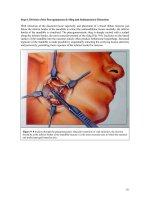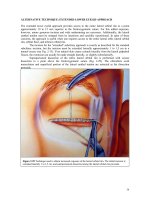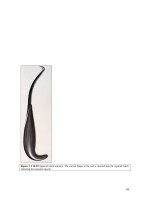General Principles for Approaches to the Facial Skeleton - part 10 pps

General Principles for Approaches to the Facial Skeleton - part 10 pps
... freeing the
periosteum from its lateral surface. The periosteal elevator can then be used to continue bluntly
dissecting inferiorly with the black-and-forth motion, taking care not to dissect ... into the
TMJ capsule (Fig. 1 2-1 0). Blunt dissection with scissors can also be used to dissect inferiorly to
the zygomatic arch. Once the dissection is approximately 1 cm be...

General Principles for Approaches to the Facial Skeleton - part 8 ppsx
... retractor into the sigmoid notch (channel
retractor, sigmoid notch retractor)(Figs. 1 0-1 0 to 1 0-1 2).
Figure 1 2 1 0-9 Subperiosteal dissection of the masseter muscle. The periosteal elevator ... inferior to the lowest part of
the bony external auditory meatus (Fig. 1 0-1 ). The average distance from the lowest point on the
external bony auditory meatus...

General Principles for Approaches to the Facial Skeleton - part 3 pdf
... superior limb of the tendon. An effective
method to pass this suture is to identify the superior limb of the canthal tendon first with small,
toothed forceps placed into the incision. The forceps are ... retractors, a scalpel is used to
icise the periorbita, taking care to stay lateral to the lacrimal sac (Fig. 3-1 1). The incision through
the periorbita is just...

General Principles for Approaches to the Facial Skeleton - part 4 doc
... of Facial Nerve
The temporal branches of the facial nerve are often called the frontal branches when they reach the
supraciliary region. The nerves provide motor innervation to the frontalis, the ... 6-4 Branches
of the facial nerve.
The distance from
the anterior
concavity of the
external auditory
canal to the crossing
of the zygomatic
arch (arrow) by t...

General Principles for Approaches to the Facial Skeleton - part 5 pot
... across the forehead from one superior temporal line to
the other. The tension throu
g
h
p
eriosteum should be 3 to 4 cm su
p
erior to the orbital rims.
75
Figure 6- 10 Draping of the patient and the ... and inferior
to where the artery pierces the medial orbital wall. With a periosteal elevator on each side of the
foramen, retraction allows the periosteum att...

General Principles for Approaches to the Facial Skeleton - part 6 pot
... relationship of facial vessels to
b
one. The onl
y
tissue between them is the
p
eriosteum.
S E C T I O N
IV
TRANSORAL
APPROACHES TO THE
FACIAL SKELETON
The midfacial and mandibular skeleton can ... in the midface. It allows relatively safe access to the entire facial surface of the
midfacial skeleton, from the zygomatic arch to the infraorbital r...

General Principles for Approaches to the Facial Skeleton - part 9 docx
...
anterior (2 mm) bands. The upper surface of the disk adapts to the contours of the fossa and
eminence of the temporal bone, and the lower surface of the disk adapts to the contour of the
mandibular ... dissection is the same as
described for the retromandibular approach.
The main advantage of the rhytidectomy approach to the ramus is the les conspic...
Từ khóa:
- ace the toefl essay part 10
- cracking the toefl ibt part 10
- the synthesis of the modified tetrapyrrole known asd1haem requires several dedicated proteins which are coded for by a set of genes that are often found adjacent to the structural gene
- how to prepare for the toefl part 10
- a rationale for introducing new leadership skills to the management
- what are the principles for responsible investment
- Báo cáo thực tập tại nhà thuốc tại Thành phố Hồ Chí Minh năm 2018
- Nghiên cứu sự biến đổi một số cytokin ở bệnh nhân xơ cứng bì hệ thống
- Nghiên cứu tổ chức pha chế, đánh giá chất lượng thuốc tiêm truyền trong điều kiện dã ngoại
- Nghiên cứu vật liệu biến hóa (metamaterials) hấp thụ sóng điện tử ở vùng tần số THz
- Nghiên cứu tổ chức chạy tàu hàng cố định theo thời gian trên đường sắt việt nam
- Giáo án Sinh học 11 bài 13: Thực hành phát hiện diệp lục và carôtenôit
- Giáo án Sinh học 11 bài 13: Thực hành phát hiện diệp lục và carôtenôit
- ĐỒ ÁN NGHIÊN CỨU CÔNG NGHỆ KẾT NỐI VÔ TUYẾN CỰ LY XA, CÔNG SUẤT THẤP LPWAN
- Phối hợp giữa phòng văn hóa và thông tin với phòng giáo dục và đào tạo trong việc tuyên truyền, giáo dục, vận động xây dựng nông thôn mới huyện thanh thủy, tỉnh phú thọ
- Phát hiện xâm nhập dựa trên thuật toán k means
- Nghiên cứu khả năng đo năng lượng điện bằng hệ thu thập dữ liệu 16 kênh DEWE 5000
- Sở hữu ruộng đất và kinh tế nông nghiệp châu ôn (lạng sơn) nửa đầu thế kỷ XIX
- Chuong 2 nhận dạng rui ro
- Tổ chức và hoạt động của Phòng Tư pháp từ thực tiễn tỉnh Phú Thọ (Luận văn thạc sĩ)
- Quản lý nợ xấu tại Agribank chi nhánh huyện Phù Yên, tỉnh Sơn La (Luận văn thạc sĩ)
- BT Tieng anh 6 UNIT 2
- Tranh tụng tại phiên tòa hình sự sơ thẩm theo pháp luật tố tụng hình sự Việt Nam từ thực tiễn xét xử của các Tòa án quân sự Quân khu (Luận văn thạc sĩ)
- Nguyên tắc phân hóa trách nhiệm hình sự đối với người dưới 18 tuổi phạm tội trong pháp luật hình sự Việt Nam (Luận văn thạc sĩ)
- Giáo án Sinh học 11 bài 14: Thực hành phát hiện hô hấp ở thực vật
- Giáo án Sinh học 11 bài 14: Thực hành phát hiện hô hấp ở thực vật